Enjoy this Guest Article on Doctor Who by Sean Nixon!
In the third episode of Matt Smith’s run on Doctor Who, “Victory of the Daleks”, Winston Churchill has unknowingly begun deploying alien tech to fight World War II and calls in the Doctor for a consult. Long story short, one of the characters is actually an alien android and he’s got a bomb in his chest primed to detonate. But, when you are a thousand year old time traveling alien with two hearts like the Doctor this sort of thing crops up from time to time. The solution? Convince the android that he’s too human to blow up.
To borrow a favorite saying on Overthinking It, I think of this as a “Magic solution to a Science Fiction problem”. An alien plot to infiltrate the British military with an android who thinks he’s human fits right into any definition you might have for science fiction. But, that’s a solution, literally, right out of Rudolph’s Shiny New Year where the vulture Eon avoids turning to stone through the power of laughter. Fantasy, through and through. Not that there’s anything wrong with that. By pairing the bomb diffusing process with android scientist’s sense of attachment to an unrequited love, the show ties the resolutions of the plot and the character arc explicitly together.
This Science Fiction/Fantasy dissonance can go the other way as well. While Doctor Who stories generally have a “rational” explanation for whatever phenomena the Doctor encounters, that doesn’t stop the show from showcasing a host of Fantasy tropes like ghosts, witches, vampires and mummies. Take for example, the episode “Tooth and Claw” which takes place in a Victorian England plagued by werewolf attacks. In this instance the creature is an alien that just happens to transform into a bipedal wolf under the full moon. A rather straight toward Fantasy problem, but with a decidedly scientific solution. The key to defeating the wolf is an elaborate moon powered laser which requires the hope diamond (painstakingly cut to perfection over years) to focus the beam.
To see how this plays out over the whole series, I have taken each storyline from the current Doctor Who (post-2005) and have given them a label in three categories: Temporal Setting, Problem Type and Solution Type. So, “Victory of the Daleks” would be (Past, Science Fiction, Magical) and “Tooth and Claw” would be (Past, Fantasy, Scientific). From here, I analyze the data to see which incarnation of the Doctor most faces Fantasy foes or relies most heavily on science to solve his problems. I also check to see if there’s a correlation between the types of problems that arise and the types of solutions employed. I’ve capped the data at season 8, since season 9 was still in progress at the time that I wrote this article.
Temporal Setting
This is the easiest axis to establish. The stories in Doctor Who take place in either the Past, the Modern Day, or the Future. In a few fringe cases, the plot itself involves time travel to such a degree that equal time is spent in the past and future. In this case, I label the setting according the the starting time (which also tends to be the ending time). For example: “The Girl in the Fireplace” gets labeled as Future since it starts out on a derelict spaceship before the Doctor begins jaunting back in time to 17th century France. On the other hand: “Listen” gets labeled as Modern Day since the story starts with the Doctor’s companion Clara going on a date in contemporary London before visiting an orphanage in the 1990s and then jumping to a point in time beyond the end of all life.
Problem Type
The problems will be broken into two categories: Science Fiction and Fantasy. Technically, all Doctor Who villains end up with some sort of science fiction explanation for their existence (mostly they’re some sort of alien). However, this has more to do with solving the problem than the problem itself. Thus, aliens that look like Werewolves (“Tooth and Claw”), aliens that look like vampires (“Vampires of Venus”), aliens that look likes ghosts (“The Unquiet Dead”), etc, will all be labeled Fantasy. For an alien threat to be labeled Science Fiction they must look like a typically SciFi alien (as is the case in “The Impossible Astronaut”). Doctor Who leans into genre tropes fairly often, so this categorization also proves fairly simple.
Solution Type
The Solutions are where things get a little more murky. My default is to label a solution as Scientific unless (a) the solution is non-repeatable or inexplicable as in “The Big Bang”, (b) the solution is tied to a character’s emotional state as in “Closing Time”, or (c) the solution invokes glowy yellow time-lord energy (the go-to deus ex machina in Doctor Who stories). These three cases constitute the magical solutions. For example, in the current season, “Under the Lake/Before the Flood” ends with a carefully constructed time travel paradox replete with logical loops for a thoroughly science-based solution. In contrast, “The Magician’s Assistant/The Witches Familiar” ends with the Doctor funneling glowy yellow time-lord energy into an old man’s life support system to resurrect the alien remains in the sewers. Just the most recent application of the magical restorative powers of glowy yellow time-lord energy.
Data
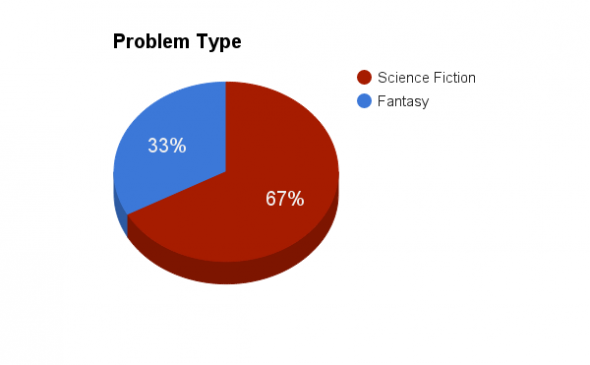 As expected, the show favors Science Fiction problems as well as Scientific solutions. In the series to date, 67% of all stories feature villains associated with the SF genre and a slightly higher 70% of the stories use a scientific approach to resolve the conflict.
As expected, the show favors Science Fiction problems as well as Scientific solutions. In the series to date, 67% of all stories feature villains associated with the SF genre and a slightly higher 70% of the stories use a scientific approach to resolve the conflict.
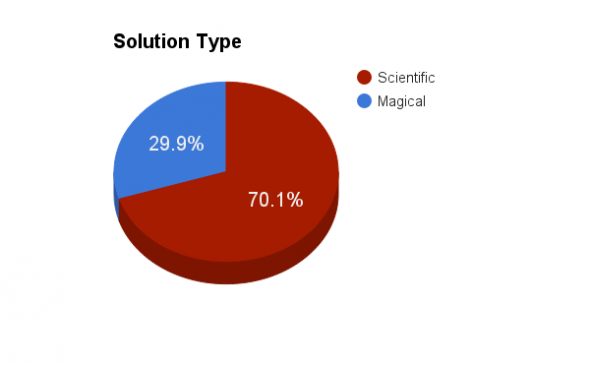
More interestingly, we can track how this breakdown has evolved along with the incarnations of the Doctor. Over the show’s 52 year run, 12 different actors have held the mantle of Doctor, and 4 since the revival in 2005. Normally designated by their number in the queue, we have Christopher Eccleston (the 9th Doctor), David Tennant (the 10th Doctor), Matt Smith (the 11th Doctor) and Peter Capaldi, (the 12th Doctor). Unlike James Bond, who is ostensibly the same person regardless of who plays him, when the actor playing the Doctor is replaced, the character of the Doctor undergoes a change in personality as well.
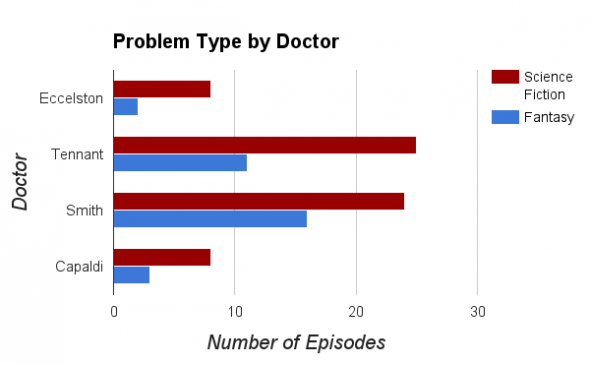
Christopher Eccleston’s representation was the most rooted in Science Fiction imagery with 80% of his villains coming from Science Fiction. From there, the show lossens up. David Tennant drops to 69% percent and then the number bottoms out with Matt Smith at 60%. This time period saw the doctor move from being an action hero out of the old SciFi pulp novels, into being almost a fairy tale-like legend. He evolves from being the subject of a conspiracy theories like in the episode “Rose”, to being a figure out of myth. This is point is directly addressed in the episode “The Pandorica Opens”, where one character remarks, “I hate good Wizards in fairy tales. They always turn out to be him [The Doctor].” Though the 12th Doctor’s (Capaldi) run is still in progress, he had SciFi villains in 73% of his stories for his first season as the Doctor, which indicates a return to a more hard SF take on the Doctor.
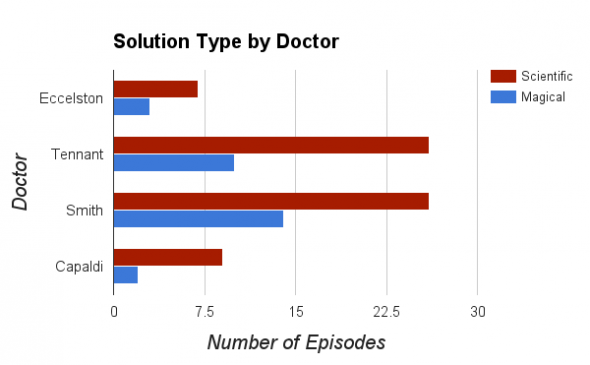
The findings on problem types are somewhat mirrored when looking at the breakdown of the solutions employed. Smith is the most likely to employ magic in his problem solving with 35% of his stories ending in an appeal to something beyond the scope of traditional science. At the other extreme, Capaldi sticks to scientific solutions a whopping 82% of the time, with a style reminiscent of Eccleston’s Doctor. While Eccleston’s score on this matter is only 70%, none of the magical solutions actually originate as his idea. Interestingly, this return to a more hard Science Fiction story telling during Capaldi’s incarnation of the Doctor also comes with a characterization of the Doctor as being once again more cold and distant.
Correlations Between Settings, Problems, and Solution
As mentioned earlier, the number of episodes in the series with Science solutions is roughly equal to the number of episodes with Science Fiction problems. But, how many of those 30% of episodes with magic solutions pair with the 33% of episodes with Fantasy problems? All three of the variables have a natural correlation, i.e., we expect Fantasy problems to crop up in when Doctor visits the Past and that the solution should have a magical flavor to it. This would give an episode with state (Past, Fantasy, Magical) Likewise, we expect stories taking place in the future to feature Science Fiction problems with scientific solutions. Since the state variables for the episode are all binary (except Temporal Setting in which case episodes set in Modern Day are thrown out) I’ve calculated their Quantum Correlation. For example, when comparing problems and solutions the equation for the correlation is:

![]() The number of episodes with Science solutions to Science Fiction problems
The number of episodes with Science solutions to Science Fiction problems
![]() The number of episodes with Magic solutions to Science Fiction problems
The number of episodes with Magic solutions to Science Fiction problems
 The number of episodes with Science solutions to Fantasy problems
The number of episodes with Science solutions to Fantasy problems
![]() The number of episodes with Magic solutions to Fantasy problems
The number of episodes with Magic solutions to Fantasy problems
![]() The total number of episodes
The total number of episodes
This is not quite the same as a least squares correlation used commonly in statistics, but it follows the same intuition, i.e., a correlation of 1 means they always match, a correlation of -1 means they are always at cross purposes, and a 0 means that it is a coin toss. If you take the correlation plus 1 all divided by 2, this gives the percent of the time the problem matches the solution.
The variables most strongly correlated, unsurprisingly, are the temporal setting and the problem. The correlation here is 0.43, or in other words, an agreement between the setting and the villain exists 72% of the time. Furthermore, a large majority of the episodes in the (Past, Science Fiction) category take place sometime in the last 100 years, a time period encompassing the pulp age and the golden age of Science Fiction. If the episodes taking place between 1915-2015 (including the modern day episodes) were instead all categorized as Future, the correlation jumps to 0.63 and agreement occurs in 82% of episodes.
In contrast, a correlation between the problem and the solution is practically nonexistent. The correlation is only 0.19, which amounts to agreement between the problem and solution 60% of the time. This is not much higher than the 50% you would expect if it was completely random. Breaking it down further, 73% of the Science Fiction problems have a scientific solution and 66% of the Fantasy problems have a scientific solution. Thus, the Doctor’s forays into magical solutions are doled out evenly to Science Fiction and Fantasy problems alike.
The Doctor doesn’t just travel through time and space, he travels through genres. One week the Doctor lands in the middle of a claustrophobic space horror and the next he finds himself embroiled in a murder mystery. The setting and the villain act in tandem to build a world that’s recognizable for the Doctor to disrupt. There’s only a weak correlation between the problem and the solution because the Doctor generally doesn’t conform to what’s expected in the genres that he inhabits. He doesn’t fight vampires with garlic and stakes, he doesn’t take on alien invasions with guns blazing. A Doctor Who solution is a careful blend of bravado, logic, and miracles distributed with a wrathful pacifism, however, a Doctor Who problem can, by design, be anything. Part of what’s contributed to the show’s incredible longevity is its ability to draw from such a diverse range of source material. And, when the show’s done putting Matt Smith’s friendly and energetic Doctor through his paces dealing with ghosts and living statues, the slate can be wiped clear for Peter Capaldi’s rude and enigmatic Doctor to outwit abandoned military tech and ultra-secure space banks.
I’m making my data set available, so feel free to tell me how I’m wrong in the comments. For Temporal Settings -1 = Past, 0 = Modern Day and 1 = Future. For Problems -1 = Fantasy and 1 = Science Fiction. For Solutions -1 = Magic and 1 = Science.
Appendix: Season 9
Season 9 was airing during the writing of this article. Since it was troublesome to have all the numbers change each week I’ve separated its discussion from the rest of the data. With only 7 separate stories, including last year’s Christmas special where the Doctor faces off against Santa, this is the shortest season in terms of data points. As such, the few fantastical elements (ghosts in the underwater labs, castle labyrinths stalked by death) weigh more heavily on the average. This moves the ratio of Science Fiction problems to Fantasy problems for the 9th Doctor more in line with his predecessors at 67%. Capaldi has, however, held the line as being the most Scientific when it comes to solutions. The correlations are all slightly decreased since this season has put the Doctor in some less common predicaments. The ghosts show up in the future and the robots show up in the distant past, but the Doctor deploys the same bombastic reasoning whenever he may be.
Sean Nixon is a mathematician at the University of Vermont specializing in nonlinear waves and optics.
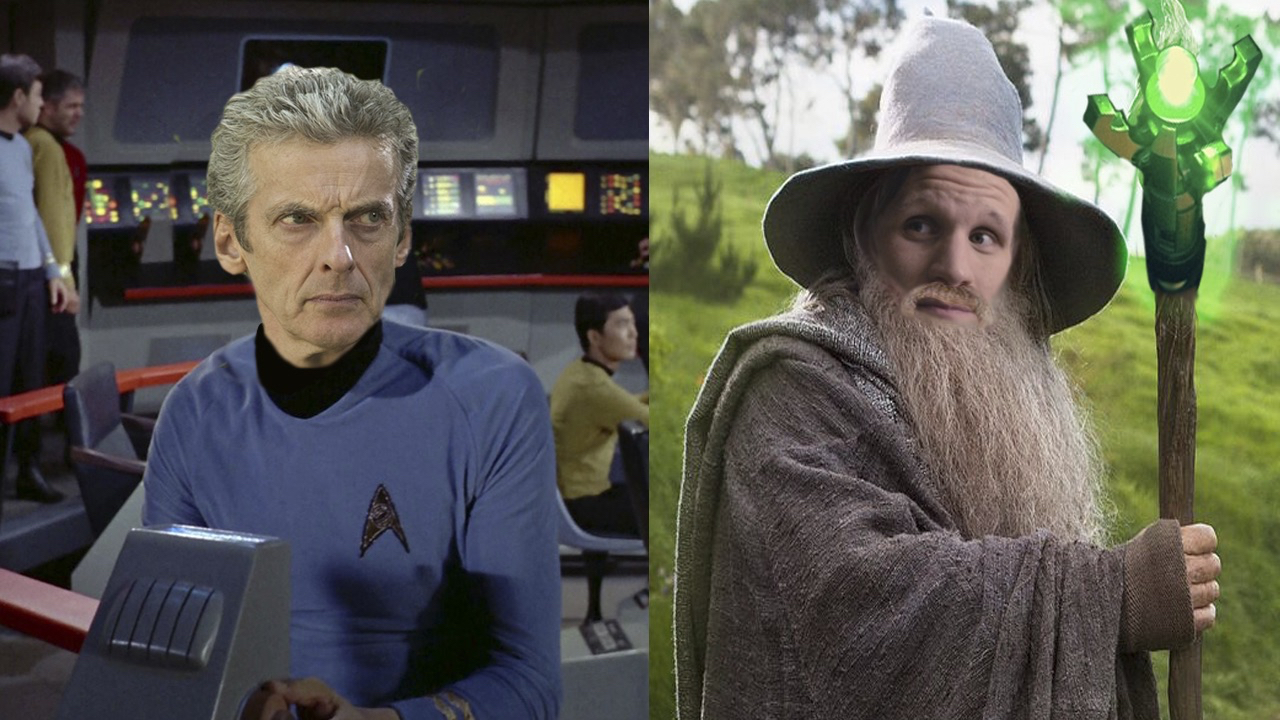
Now, to see how this works for the Classic Series… Then the Big Finish audios….
It’s a really, really huge data set…..